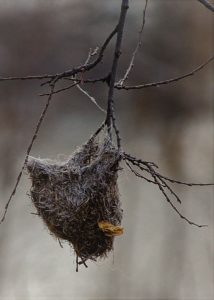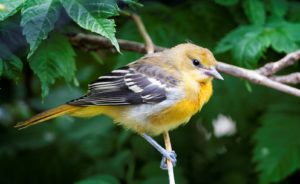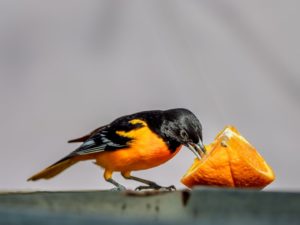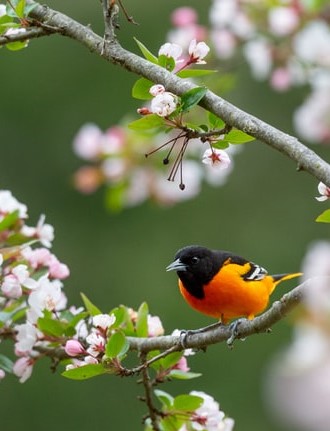Baltimore Orioles bring brilliant color and cheerful songs to our summers. The male is black, with an orange breast, tail and shoulders and has white on the wings. The female is pale olive green to brownish above, with a dull yellow to yellowish-orange below and two white wing stripes.
Open woodlands, forest edges, and areas with tall shade trees are attractive to Baltimore Orioles. They tend to nest in cottonwood, maple, poplar, sycamore, birch or willow trees, 14- 60 feet above the ground.
Shaped like a pouch or bag, the nest is often attached at the tips of branches, hanging over an open space. Frequently they will be found near a water source such as a lake, river or stream. Plant materials, strips of bark, grass, yarn, string and/or hair may be used to construct the pouch, which is lined with soft fibers such as dandelion or milkweed down.

Oriole Nest by Jeffrey Hamilton
The female lays 4-6 pale blue to grayish eggs, with irregular dark blotches. The incubation period is about 12-14 days, with the babies leaving the nest 12-13 days after hatching.

Juvenile Baltimore Oriole by Phillip Brown
Being migratory birds, Baltimore Orioles usually arrive in our area between mid-April and mid-May. Many will stay through the summer, then migrate southward again in late July to September. They winter in Central America and the northern areas of South America, spending more months in these regions than in their summer breeding grounds.

Oriole Feeding on Orange by Patrice Bouchard
Insects, nectar and fruits make up most of an oriole’s diet. They will frequently come to oriole feeders with nectar in them, and they have been known to feed from hummingbird feeders. Although well known for eating oranges, they may also come to apple slices, cherries, raisins or bananas. Grape jelly is attractive to them as well. There are many different types of feeders available for offering nectar, fruit and/or jelly.
If you have orioles in your area and trees they like to nest in, there is a good chance you can attract them to your yard with feeders and water. The Baltimore Orioles will reward your efforts with their beauty and song.

